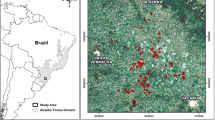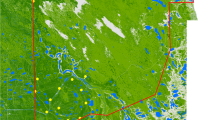Abstract
Globally anthropogenic pressures on natural environments have caused species decline. Ground dwelling bird species declined in numbers because of loss of habitat and nesting sites. Protected areas (PAs) are generally perceived as areas with little disturbance; however, many have/are also subjected to anthropogenic land use change, such as agroforestry. Consequently, we investigated the presence and habitat use of a terrestrial avian species, the Crested Guinea-fowl (Guttera edouardi), in iSimangaliso Wetland Park, South Africa, a PA with varying land use change. We used single-season camera trap data from 99 trap stations across 24 days, and single season occupancy models to quantify the influence of habitat conversion and habitat characteristics on occupancy and detection probability of Crested Guinea-fowl. The average site occupancy (±standard error) and detection probability (±standard error) under the variable influence was 0.40 ± 0.07 and 0.43 ± 0.06 respectively from the top models. The most influential variables were natural forests, shrub cover, leaf litter, weed dominance, distance to water and narrow path. The natural forests, weed dominance and shrub cover positively influenced the occupancy of Crested Guinea-fowl. Leaf litter and distance to water had a positive influence on detection probability while narrow path had a negative influence. Our findings highlight the importance of natural forests to the survival of Crested Guinea-fowl in landscapes modified for agroforestry. Management initiatives are mandatory to ensure protection of adequate natural habitat for the conservation of forest specialists.
Zusammenfassung
Reaktion des Kräuselhauben-Perlhuhn ( Guttera edouardi ), eines Waldspezialisten, auf die räumliche Variation in der Landnutzung im iSimangaliso Feuchtgebiet in Südafrika Anthropogene Belastungen natürlicher Lebensräume haben weltweit zu einem Artenrückgang geführt. Bodenbewohnende Vogelarten sind aufgrund von Habitat- und Neststandortrückgang unter diesen zahlenmäßig rückläufigen Arten. Schutzgebiete gelten generell als Gebiete mit geringer Störung, aber viele von ihnen sind anthropogenen Veränderungen in der Landnutzung, wie etwa dem Waldfeldbau, ausgesetzt. Wir untersuchten deshalb die Präsenz und Habitatnutzung einer bodenbewohnenden Vogelart, dem Kräuselhaubenperlhuhn (Guttera edouardi), im iSimangaliso Feuchtgebiet in Südafrika, einem Schutzgebiet mit unterschiedlicher Veränderung in der Landnutzung. Um den Einfluss von Habitatumwandlung und Habitatcharakteristika auf die Besetzung und Nachweiswahrscheinlichkeit des Kräuselhauben-Perlhuhns zu bestimmen, verwendeten wir Daten von 99 Kamerafallen über 24 Tage einer Saison und Modelle zur Besetzung in derselben Saison. Die mittlere Besetzungsrate (±Standardfehler) und Nachweiswahrscheinlichkeit (± Standardfehler) lag unter dem Einfluss der Variablen bei 0,40 ± 0,07 und 0,43 ± 0,06 des jeweils besten Modells. Die Variablen mit dem größten Einfluss waren natürlicher Wald, Buschbedeckung, Laubstreu, Dominanz an Kräutern, Entfernung zum Wasser und die Enge des Pfades. Natürlicher Wald, Dominanz an Kräutern und Buschbedeckung hatte einen positiven Einfluss auf die Besetzungsrate mit Kräuselhauben-Perlhühnern. Laubstreu und Entfernung zum Wasser beeinflusste die Nachweiswahrscheinlichkeit positiv, während die Enge des Pfades einen negativen Einfluss hatte. Unsere Ergebnisse unterstreichen die Bedeutung von natürlichem Wald für das Überleben des Kräuselhauben-Perlhuhns in einer von Waldfeldbau modifizierten Landschaft. Managementinitiativen, die den Schutz angemessener Flächen natürlichen Habitats gewährleisten, sind für die Erhaltung von Waldspezialisten unerlässlich.
Similar content being viewed by others
References
Allan DG, Harrison JA, Navarro R, Van Wilgen BW, Thompson MW (1997) The impact of commercial afforestation on bird populations in Mpumalanga Province, South Africa—insights from bird-atlas data. Biol Conserv 79:173–185
Aratrakorn S, Thunhikorn S, Donald PF (2006) Changes in bird communities following conversion of lowland forest to oil palm and rubber plantations in southern Thailand. Bird Conserv Int 16:71–82
Armstrong AJ, Van Hensbergen HJ (1996) Impacts of afforestation with pines on assemblages of native biota in South Africa. S Afr J For 175:35–42
Barnes KN (2000) The Eskom red data book of birds of South Africa, Lesotho and Swaziland. Bird Life South Africa, Johannesburg
Bennun L, Dranzoa C, Pomeroy D (1996) The forest birds of Kenya and Uganda. J East Afr Nat yHist 85:23–48
BirdLife International (2015) Guttera edouardi. http://www.birdlife.org. Accessed 10 Oct 2015
Brockerhoff EG, Jactel H, Parrotta JA, Quine CP, Sayer J (2008) Plantation forests and biodiversity: oxymoron or opportunity? Biodivers Conserv 17:925–951
Brown ML, Donovan TM, Schwenk WS, Theobald DM (2014) Predicting impacts of future human population growth and development on occupancy rates of forest-dependent birds. Biodivers Conserv 170:311–320
Burnham KP, Anderson DR (2002) Model selection and multi model inference: a practical information-theoretic approach. Springer, New York
Carrara E, Arroyo-Rodríguez V, Vega-Rivera JH, Schondube JE, de Freitas SM, Fahrig L (2015) Impact of landscape composition and configuration on forest specialist and generalist bird species in the fragmented Lacandona rainforest, Mexico. Biodivers Conserv 184:117–126
Chamberlain DE, Fuller RJ (2001) Contrasting patterns of change in the distribution and abundance of farmland birds in relation to farming system in lowland Britain. Glob Ecol Biogeogr 10:399–409
Coolen I, Dangles O, Casas J (2005) Social learning in non-colonial insects? Curr Biol 15:1931–1935
Donnelly R, Marzluff JM (2004) Importance of reserve size and landscape context to urban bird conservation. Conserv Biol 18:733–745
Ezemvelo KZN Wildlife (2011) 2008 KZN Province Land-Cover Mapping (from SPOT5 Satellite imagery circa 2008). Prepared for Ezemvelo KZN Wildlife (Biodiversity Research), South Africa
Gaston KJ, Fuller RA (2008) Commonness, population depletion and conservation biology. Trends Ecol Evol 23:14–19
Helle P, Muona J (1985) Invertebrate numbers in edges between clear-fellings and mature forests in northern Finland. Silva Fenn 19:281–294
Hines JE (2006) PRESENCE-Software to estimate patch occupancy and related parameters: USGS-PWRC. http://www.mbr-pwrc.usgs.gov/software/presence.html. Accessed 3 April 2015
Jansen R, Little RM, Crowe TM (1999) Implications of grazing and burning of grasslands on the sustainable use of francolins (Francolinus spp.) and on overall bird conservation in the highlands of Mpumalanga province, South Africa. Biodivers Conserv 8:587–602
Lawes MJ, Fly S, Piper SE (2006) Gamebird vulnerability to forest fragmentation: patch occupancy of the Crested Guinea-fowl (Guttera edouardi) in Afromontane forests. Anim Conserv 9:67–74
Lee MB, Carroll JP (2014) Relative importance of local and landscape variables on site occupancy by avian species in a pine forest, urban, and agriculture matrix. For Ecol Manag 320:161–170
Leslie AJ, Spotila JR (2001) Alien plant threatens Nile crocodile (Crocodylus niloticus) breeding in Lake St. Lucia, South Africa. Biol Conserv 98:347–355
Loyn RH, McNabb EG, Macak P, Noble P (2007) Eucalypt plantations as habitat for birds on previously cleared farmland in south-eastern Australia. Biol Conserv 137:533–548
Mackenzie DI (2005) What are the issues with presence-absence data for wildlife managers? J Wildl Manag 69:849–860
MacKenzie DI, Nichols JD, Lachman GB, Droege S, Royle JA, Langtimm CA (2002) Estimating site occupancy rates when detection probabilities are less than one. Ecology 83:2248–2255
MacKenzie DI, Nichols JD, Royle JA, Pollock KP, Bailey LL, Hines JE (2006) Occupancy estimation and modelling: inferring patterns and dynamics of species occurrence. Academic Press, New York
Malan G (1998) Summer grassland cover on cattle farms in KwaZulu-Natal: does it limit nesting habitat for helmeted guineafowl? S Afr J Wildl Res 28:105–109
Maphisa DH, Donald PF, Buchanan GM, Ryan PG (2009) Habitat use, distribution and breeding ecology of the globally threatened Rudd’s lark and Botha’s lark in eastern South Africa. Ostrich 80:19–28
Millan CH, Develey PF, Verdade LM (2015) Stand-level management practices increase occupancy by birds in exotic Eucalyptus plantations. For Ecol Manag 336:174–182
Munday PL (2004) Habitat loss, resource specialization, and extinction on coral reefs. Glob Chang Biol 10:1642–1647
Naoe S, Sakai S, Masaki T (2012) Effect of forest shape on habitat selection of birds in a plantation-dominant landscape across seasons: comparison between continuous and strip forests. J For Res 17:219–223
Neuschulz EL, Botzat A, Farwig N (2011) Effects of forest modification on bird community composition and seed removal in a heterogeneous landscape in South Africa. Oikos 120:1371–1379
Nustad KG (2011) Performing natures and land in the iSimangaliso Wetland Park, South Africa. Ethnos 76:88–108
Péron G, Altwegg R (2015) Twenty-five years of change in southern African passerine diversity: nonclimatic factors of change. Glob Chang Biol 21:3347–3355
Pimm SL, Raven P (2000) Biodiversity: extinction by numbers. Nature 403:843–845
Porter RN (2013) South Africa’s first World Heritage Site. In: Perissinotto R, Stretch DD, Taylor RH (eds) Ecology and conservation of estuarine ecosystems: Lake St Lucia as a global model. Cambridge University Press, Cambridge, pp 1–19
Radford JQ, Bennett AF (2007) The relative importance of landscape properties for woodland birds in agricultural environments. J Appl Ecol 44:737–747
Ramesh T, Downs CT (2014) Land use factors determining occurrence of Red-necked Spurfowl (Pternistis afer) in the Drakensberg Midlands, South Africa. J Ornithol 155:471–480
Ramesh T, Kalle R, Rosenlund H, Downs CT (2016) Native habitat and protected area size matters: Preserving mammalian assemblages in the Maputaland Conservation Unit of South Africa. For Ecol Manag 360:20–29
Royle JA, Nichols JD (2003) Estimating abundance from repeated presence-absence data or point counts. Ecology 84:777–790
Styring AR, Ragai R, Unggang J, Stuebing R, Hosner PA, Sheldon FH (2011) Bird community assembly in Bornean industrial tree plantations: effects of forest age and structure. For Ecol Manag 261:531–544
Sutherland WJ, Armstrong-Brown S, Armsworth PR, Tom B, Brickland J, Campbell CD, Watkinson AR (2006) The identification of 100 ecological questions of high policy relevance in the UK. J Appl Ecol 43:617–627
Valeix M, Fritz H, Matsika R, Matsvimbo F, Madzikanda H (2008) The role of water abundance, thermoregulation, perceived predation risk and interference competition in water access by African herbivores. Afr J Ecol 46:402–410
Van Niekerk JH (2015) Vocal behaviour of crested guinea-fowl (Guttera edouardi) based on visual and sound playback surveys in the Umhlanga Lagoon Nature Reserve, KwaZulu-Natal Province, South Africa. Avian Res 6:1–8
Van Niekerk JH, Barendse M, Mare F (2009) Behaviour of Red necked spurfowl Pternistis afer in the Boknes and Cannon Rock coastal resorts, Alexandria district, Eastern Cape Province, South Africa. Ostrich 80:43–45
Vetter D, Hansbauer MM, Végvári Z, Storch I (2011) Predictors of forest fragmentation sensitivity in Neotropical vertebrates: a quantitative review. Ecography 34:1–8
Watson JE, Whittaker RJ, Dawson TP (2004) Habitat structure and proximity to forest edge affect the abundance and distribution of forest-dependent birds in tropical coastal forests of south eastern Madagascar. Biol Conserv 120:311–327
Watts BD (1991) Effects of predation risk on distribution within and between habitats in savannah sparrows. Ecology 72:1515–1519
White GC, Burnham KP (1999) Program MARK: survival estimation from populations of marked animals. Bird Study 46:120–139
Acknowledgments
We would like to thank the University of KwaZulu-Natal and the Hans Hoheisen Charitable Trust for funding the project. We are grateful to iSimangaliso Wetland Park Authority and Ezemvelo KZN Wildlife for permission to conduct research in the park. We would like to thank E. Kheswa for her assistance during the project work.
Author information
Authors and Affiliations
Corresponding author
Additional information
Communicated by T. Gottschalk.
Rights and permissions
About this article
Cite this article
Maseko, M.S.T., Ramesh, T., Kalle, R. et al. Response of Crested Guinea-fowl (Guttera edouardi), a forest specialist, to spatial variation in land use in iSimangaliso Wetland Park, South Africa. J Ornithol 158, 469–477 (2017). https://doi.org/10.1007/s10336-016-1406-7
Received:
Revised:
Accepted:
Published:
Issue Date:
DOI: https://doi.org/10.1007/s10336-016-1406-7








